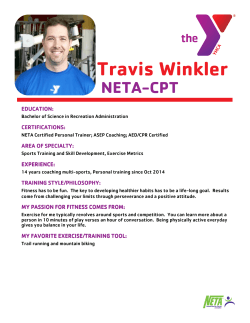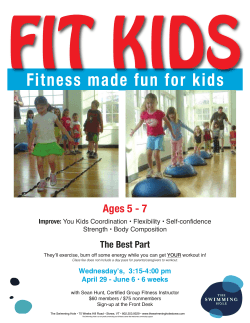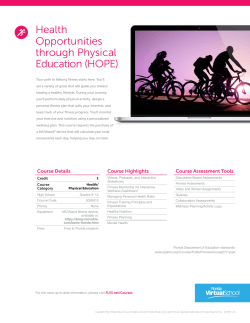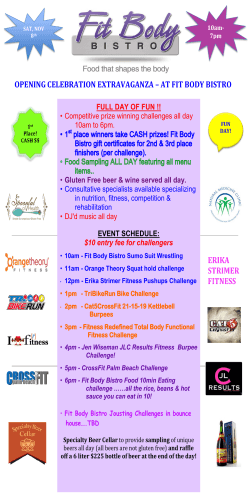
a study on the awareness of physical activities among teachers in
International Journal of Physical Education, Fitness and Sports J o ur na l ho mep a ge: www .ij p e fs. n o no l y mp ict i me s .o rg ISSN: 2277: 5447 | Vol.4.No.1 | March’2015 A STUDY ON THE AWARENESS OF PHYSICAL ACTIVITIES AMONG TEACHERS IN RELATION TO THEIR SEX, AGE AND TYPE OF SCHOOL Dr. Vivek Solankia and Dr. Jyoti Solankib a Assistant Professor, Maharaja Surajmal Institute of technology,c-4, janakpuri, New Delhi,India. b Assistant Professor,Government College Badli,Jhajjar, Haryana. Abstract: The study was designed to study the awareness of physical activities among teachers in relation to sex, age and type of school. A self made questionnaire was developed and administered. The data was collected from 100 teachers of secondary level from government, private and public schools .The statistical techniquest-test,χ2 test and percentage analysis were used for the analysis of the data. The results revealed (a) No significant difference in the awareness of physical fitness activities among teachers in relation to their sex; age and type of school (b) No significant difference in the use of physical fitness activities among teachers in relation to their sex, age and type of school. Key words: Awareness, Physical activities, Sex, Age, Type of school (on the basis of affiliation) Introduction The development of a nation in social, economic, political, cultural and scientific spheres depends upon its people’s well-being. There is a direct relationship between the development of nation and the wellbeing of its human resource. A healthy citizen is an asset to the country. Also, every human being possesses both body and mind. From holistic perspective it may be stated that people should develop a sound body with healthy mind, that is, organized and well integrated personality to live peacefully with other members of the society. Thus, the wisdom imparted to us by the ancient Greeks, “A sound mind dwells in a sound body”, still applies today. But it is a matter of great apathy that in 21st century, physical inactivity has become the serious problem of the world. Approximately two million deaths every year are attributable to physical inactivity. These relate closely to changes in lifestyle, stress and unhealthy diet. J.F. Kennedy rightly said, “Physical fitness is not only one of the most important keys to a healthy body, but it is also the basis of dynamic and creative intellectual activity.” In today’s hectic life style this statement clearly shows that “physical fitness” is emerging as a national need just like other needs namely food, shelter, cloth, knowledge, wealth, security etc. The physical inactivity is of 58 | P a g e International Journal of Physical Education, Fitness and Sports J o ur na l ho mep a ge: www .ij p e fs. n o no l y mp ict i me s .o rg ISSN: 2277: 5447 | Vol.4.No.1 | March’2015 international concern as it is eating up the productivity of the persons and the country as a whole. When something has to be changed in the society at national or international concern, the role of education cannot be ignored. All the educational commissions directly or indirectly emphasized the importance of physical fitness. Like, according to Secondary Education Commission (1952-54), “Unless physical education is accepted as an integral part of education and the education authorities recognize its need in all schools, the youth of the country which form its most valuable assets will never be able to pull their full weight in national welfare”. Also according to Indian Education Commission (1964-66), “Physical education must be emphasized that such education contributes not only to physical fitness but also to physical efficiency, mental alertness and the development of certain qualities like perseverance, spirit, leadership, and obedience to rules, modernization in victory and balance in defeat”. The wisdom of each individual would be beneficial if physical fitness becomes not only the concern of the nation, but of the individual too. Physical fitness is defined as “the ability to carry out daily tasks with vigor and alertness, without undue fatigue and with ample energy to enjoy leisure time pursuits and to meet unforeseen emergencies”. Achieving health and remaining healthy includes two components, i.e., performing physical fitness activities and nutritious diet. This means that mere thinking, knowing and wishing don’t bring good health one has to be aware about the physical fitness activities and should perform them in order to be fit and healthy. If the future citizens need to be reoriented about the importance of physical fitness in their lives, they are the teachers who can do this task effectively as they are considered role models by the students. But in context of this, along with children being physically fit, it is most important for the teachers to be physically fit themselves, so that they could be idol role models. Need of the study: Teacher as the nation builder is a person who takes the responsibility for the holistic development, including physical development of the child, so that the future citizens of the country could be productive. And if it comes to developing a positive attitude towards being fit, it is the responsibility of all the teachers, regardless of the subject they teach, to be physically active and fit so that they could become good role models for their students. In today’s fast changing modernized society, the teacher’s role have drastically changed and they have to play a multifaceted role due to which teachers are also undergoing stress and following unhealthy lifestyle. So if the teachers themselves are under depression, stress, lethargic and inactive, then the quality of the human resource produced every year by them would definitely under a big question mark. All the future citizens are needed to recognize the importance of being physically fit in the present framework of modernization and complex lifestyle to survive and succeed in cut throat competition. As a teacher’s special relationship with young people or future 59 | P a g e International Journal of Physical Education, Fitness and Sports J o ur na l ho mep a ge: www .ij p e fs. n o no l y mp ict i me s .o rg ISSN: 2277: 5447 | Vol.4.No.1 | March’2015 citizens at school provides him with a unique opportunity of giving them the training or making them aware about the importance of physical fitness in their life .So the investigator selected this topic to find out the answer to the following questions: How much the teachers know about the physical fitness and physical fitness activities? What are the views of teachers about the physical fitness? Are the teacher’s health conscious? Who is more health conscious: males or female teachers? What physical activities do they perform to remain fit in their day to day living? Why do the teachers perform physical fitness activities, because they suffer from some health problems or do it already being fit? Does the knowledge and use of physical fitness activities by the teachers is influenced by the type of school to which they belong? Do the teachers have ample availability of time and space to do fitness activities? Do the teachers increase the performance of fitness activities as they grow old? Do the teachers take good care of their diet too? Objectives: The objectives of the study were to find out: 1. The awarenessof physical fitness activitiesamong the school teachers in relation to their sex, age and type of school. 2. The use of physical fitness activities among the school teachers in relation to their sex, age and type of school. Hypothesis: (1)There will be no significant difference in the awareness of physical fitness activities among teachers in relation to their: (a)Sex (b)Age (c)Type of school (2)There will be no significant difference in the use of physical fitness activities among teachers in relation to their: (a)Sex (b)Age (c)Type of school 60 | P a g e International Journal of Physical Education, Fitness and Sports J o ur na l ho mep a ge: www .ij p e fs. n o no l y mp ict i me s .o rg ISSN: 2277: 5447 | Vol.4.No.1 | March’2015 Sample: A sample of 102 school teachers at secondary level were taken from three different types of schools, that is, two government schools, two central schools and two public schools. Allocation of sample unit Type of School S.No Name of the School No.of Total teachers Teachers 1. SarvodhyaCo.Ed senior Secondary 19 35 Government School schools 2. SarvodhyaBalVidyalya “B Block” 16 Public Schools Central Schools 3. 4. 5. 6. MountAbu Public School Prestige Convent Senior Sec.School KendriyaVidyalya, Sec-22 KendriyaVidyalya, Sec-3 Total Teachers 20 17 14 16 37 30 102 Design: The design of the present study was based on sample of 102 school teachers at secondary level. The descriptive survey research method was used. The variables in the present study, that is, Awareness and use of physical fitness activities by the teachers were taken as dependent variable and age, sex and type of school were taken as independent variables. Tools used: For this study the investigator herself framed and administered a questionnaire titled as “We are what we do and eat”. Procedure: For the purpose of data collection, permission was sought from the principals of randomly chosen schools located in north Delhi. Two central schools, two government schools and two public schools were selected. The investigator went personally to the respective schools and contacted all the secondary level school teachers. The questionnaire was administered on the teachers by giving them instructions regarding filling the responses. After collecting data, scoring was done and results were compared by using statistical techniques and then interpreted accordingly. 61 | P a g e International Journal of Physical Education, Fitness and Sports J o ur na l ho mep a ge: www .ij p e fs. n o no l y mp ict i me s .o rg ISSN: 2277: 5447 | Vol.4.No.1 | March’2015 Statistical techniques: To analysis the data descriptive and inferential statistical is used.t-test is used to find out the awareness and χ2 is used to find the use of physical fitness activity by the teachers. Percentage and graphical representation is used to analyze the data. Table: 1: Testing of Hypothesis – 1 Variables Mean S.D. df Males 15.34 7 100 Sex Females 17.7 6 Adulthood 17.06 2.9 100 Age Oldage 16.57 2.1 35 2.4 70 Type of School Govt. Schools Public Schools 37 2.7 Central Schools 16.6 2.7 65 Public Schools 17.48 2.9 Govt. Schools 16.4 2.4 63 Central Schools 16.96 2.9 t-value 11.66 NS 0.936 NS 1.79 NS 0.747 NS 0.834 NS *Significant at .05 level * Significant at .01 level 1 N.S Not significant Findings of the study: 1. Awareness about physical fitness and activities in relation to teachers: (a) Sex The teacher’s sex don’t have any impact on the awareness about physical fitness and activities, that is, both male and female teachers have more or less same level of awareness. There is no influence of teachers sex on the knowledge enhancement about physical fitness and activities after the entered their profession. 62 | P a g e International Journal of Physical Education, Fitness and Sports J o ur na l ho mep a ge: www .ij p e fs. n o no l y mp ict i me s .o rg ISSN: 2277: 5447 | Vol.4.No.1 | March’2015 Both the male and female teachers consider T.V., Magazines and friends as the useful source of knowledge enhancement about physical fitness and activities. More of the female teachers frequently and regularly read health magazines than males. (b) Age The level of awareness about the physical fitness and activities is same for both the adult and old age teachers. The knowledge enhancement of the teachers about physical fitness and activities is independent of their age. More of the adult teachers consider all the three i.e T.V, Magazines and friends as the useful source of knowledge about physical fitness and activities than old age teachers. The frequency of reading health magazines is same for both the adult teachers and old age teachers. (c) Type of School The awareness about physical fitness and activities is same for the teachers of government, public and control school. Government school teachers are most benefited in reference to knowledge enhancement after entering their profession, than the central and public school teachers. The teachers of all the three type of schools consider T.V, Magazines and friends as useful source of knowledge enhancement The teachers of public school are the most regular to read health magazines while the government school and central school teachers read it occasionally or rarely. Table: 2: Testing of Hypothesis – 2 Variables df χ2 Sex Age Type of School Male Female Adulthood Old age Govt. Schools Public Schools Central Schools 1 1.47NS 1 .059 NS 2 .8775 NS *Significant at .05 level, * Significant at .01 level, N.S Not significant 63 | P a g e International Journal of Physical Education, Fitness and Sports J o ur na l ho mep a ge: www .ij p e fs. n o no l y mp ict i me s .o rg ISSN: 2277: 5447 | Vol.4.No.1 | March’2015 2. Use of physical fitness activities among teachers in relation to their: (a)Sex The use of physical fitness activities is more or less same in male and female teachers. Male teachers prefer to do jogging, while female teachers prefer to do yoga. Both the male and female teachers consider yoga as the most beneficial physical fitness activity. Both the male and female teachers consider yoga as the most easily performed physical fitness activity. (b)Age Use of physical fitness activities is comparatively same in adult teachers and old age teachers. Most of the teachers in adulthood or old age prefer to do jogging. The teachers in adulthood or old age consider yoga as the most easily performed physical fitness activity. The adult and old age teachers, both consider yoga as the most beneficial physical fitness activity. (c)Type of School The use of physical fitness activities is comparatively same in the teachers belonging to different type of school While the government school teachers prefer to do jogging but the public and central school teachers prefer to do yoga. The teachers of three different type of schools consider yoga as the most easily performed physical fitness activity. Yoga is considered as the most beneficial physical fitness activity by the teachers of government public and central schools. 64 | P a g e International Journal of Physical Education, Fitness and Sports J o ur na l ho mep a ge: www .ij p e fs. n o no l y mp ict i me s .o rg ISSN: 2277: 5447 | Vol.4.No.1 | March’2015 Conclusion: Physical health and fitness has been reported as an important factor influencing all the aspects of an individual, let it be,intellectual,social,emotional,physical,spiritual and moral. But after analyzing the findings of the above stated research it is a matter of great apathy that all the teachers although being aware about the importance of being fit and also know the ways of staying healthy, but negligible of the teachers are snatching time from their schedule for their physical fitness. Some of the teachers who are practicing one or other physical fitness activity are not regular, and being fit is not a day action, it is a process and regular task. Thus, this study could be helpful for Educational planners and developers to refocus on the need to make health education an integral and compulsory part of school and college curriculum. Also for the in-service teachers there is a need to conduct the refresher courses about being physically fit and for the students the school administrators can organize summer camps based on the themes of physical education References: [1] Abdul Aziz, A. Almustafa.2000.“A comparative study of physical education fitness for primary students in schools in the Eastern province-Saudi Arabia”.Scientific journal of king Faisal University.Vol.68 (1) [2] Beck, K.H. and Lund, A. K.1981. “The effect of health thread seriousness and personnel Efficacy upon intention and behaviour”.Journal of Applied and Social psychology.Vol.II,PgNo. 401-415. [3] Cale, Lorraine .2000.“Physical activity promotion in secondary schools”.European physical education review ; Volume 6 (71) [4] Chand, Piar .2006. “Psychological factors in the development of work stress”.Journal of community guidance and research,Vol.23 (2),Pg No.178-186. [5] Dixit, V. K. and Rajesh .2004.“Productive ageing : health care, nutrition and social support in Indian context – Critical Analysis of the Policy and the programme implementation on older persons”.Indian journal of population education.Vol.4 (2) ; PgNo. 18-23. [6] Downie, R. S.Tannahill, C. and Tannahill, A.1996.“Health promotion : Models and values” ; Oxford University Press. [7] Garrett, Henry E. .1965.“Statistics in Psychology and Education”.VakilsFegger and Simons Pvt. Ltd. ,Second Edition. 65 | P a g e International Journal of Physical Education, Fitness and Sports J o ur na l ho mep a ge: www .ij p e fs. n o no l y mp ict i me s .o rg ISSN: 2277: 5447 | Vol.4.No.1 | March’2015 [8] Hagger Martin, Lan Almond and Arnd Kruger.2008.“Children’s Physical Activity Levels and attitudes towards physical activity”.European physical Education review,Volume 3(144) [9] Harold ,W.Bernar.2007.“Mental Hygiene for Classroom Teachers”.TataMcgrawHills ; Page No.425-444. [10] Hayes Sid, Katene Will and Susan Capel.2008. “Does knowing stuff like PSHE and citizenship make me a better teacher?: Student teacher in the figuration”.European Physical Education Review,Vol.14(243) [11] Rajendran. R. and R. Ravichandran. 2007.“Perceived Sources of Stress among the teachers”.Journal of Indian Academy of Applied Psychology,Vol.33 (1),Pg No. 133-136. [12] Sharma, S.2001.“Effect of Yoga exercises on mental health and anxiety at B.Edlevel”.UnpublishedM.Ed Dissertation, Punjab University, Chandigarh. ***** 66 | P a g e
© Copyright 2026









